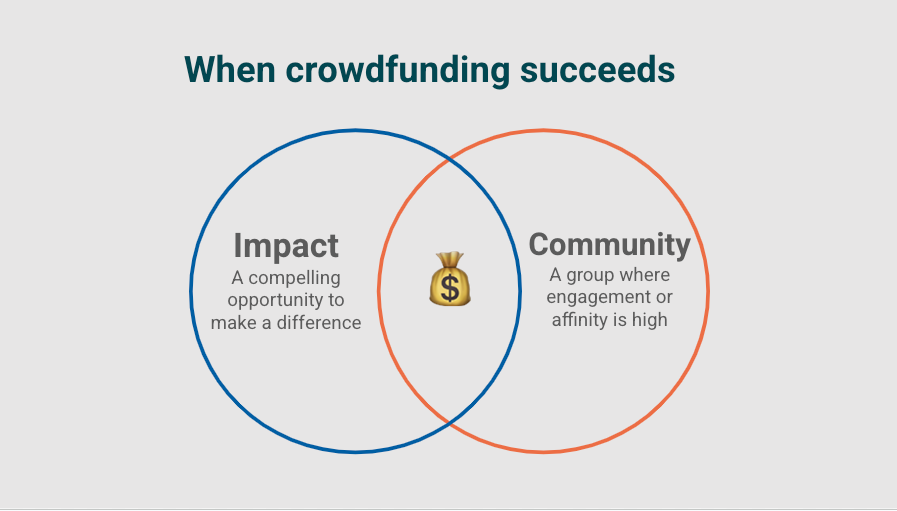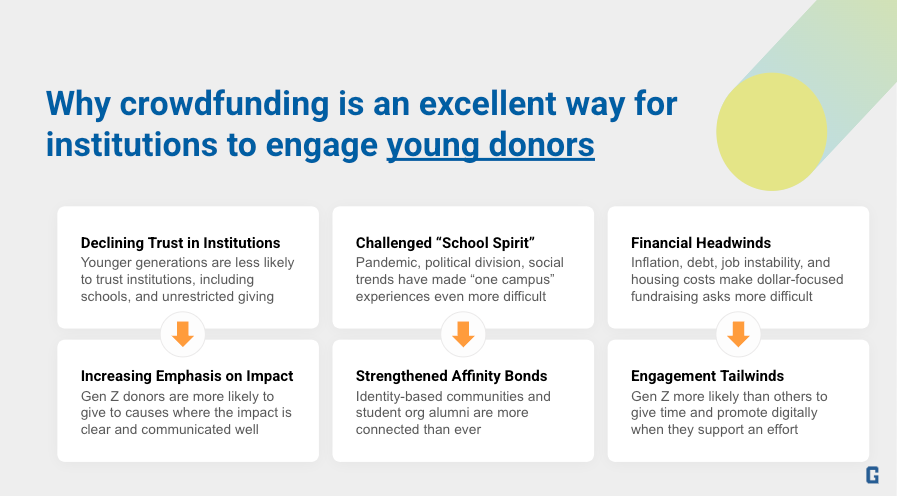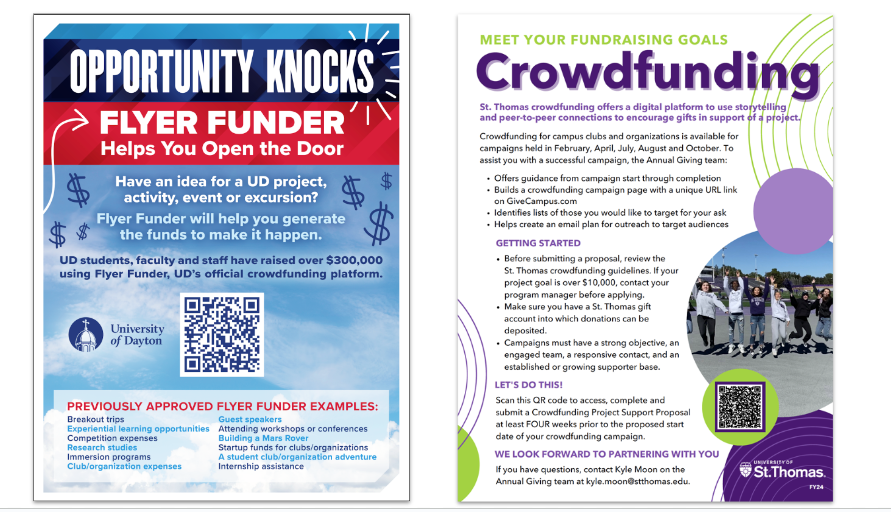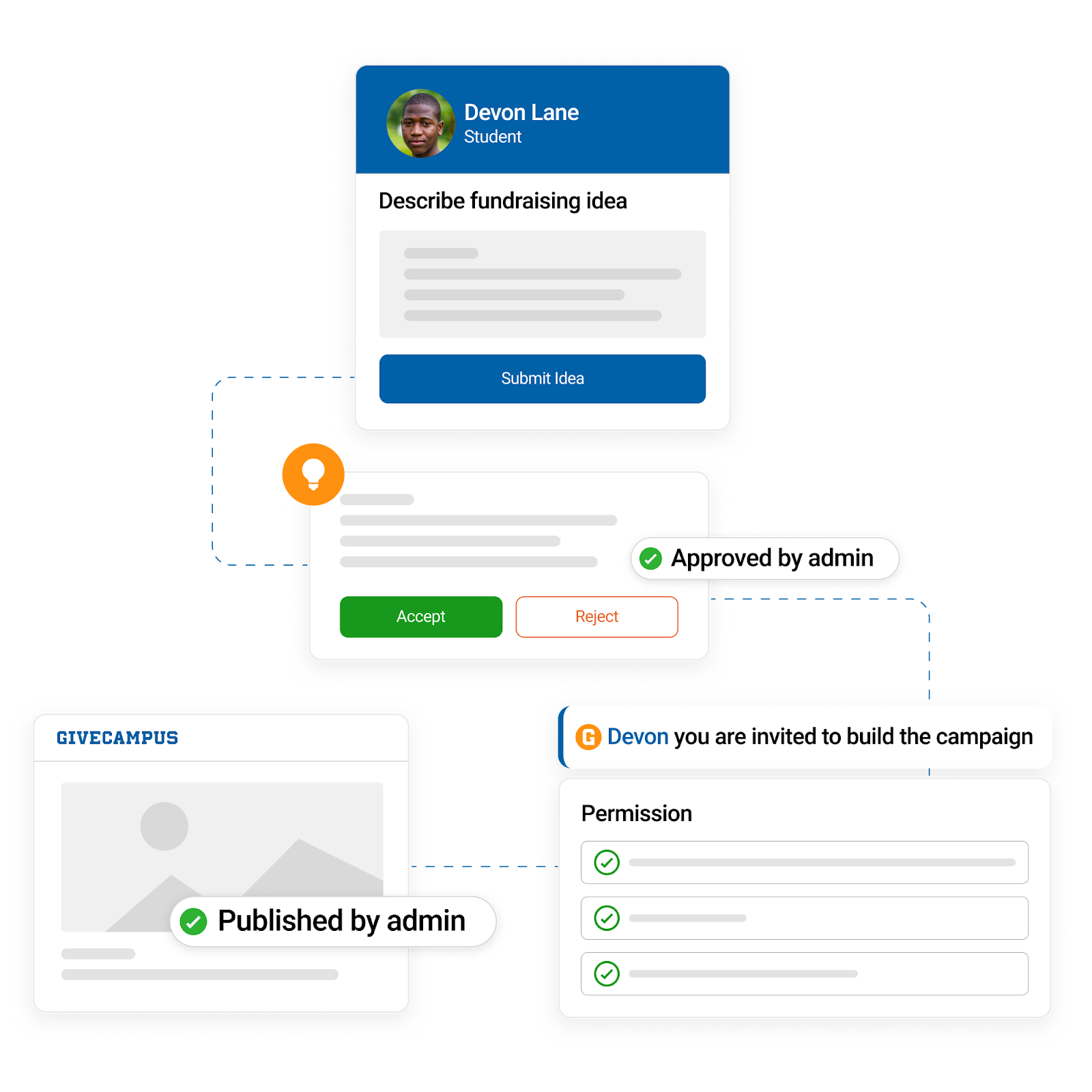Crowdfunding is hardly a new concept. Almost a decade ago, a wave of new digital fundraising platforms helped democratize and popularize crowdfunding via the Internet. Platforms like GiveCampus made it easier for institutions to raise money from their communities online and fund important initiatives.
In recent years, we’ve seen this tried-and-true strategy surge in popularity. A global pandemic and wave of social justice movements, paired with technological advances and social media helped propel crowdfunding campaigns to new heights—especially with younger audiences.
Between 2021 and 2023, GiveCampus saw the number of crowdfunding campaigns hosted by our Partner schools almost double. This trend has continued, with the number of crowdfunding campaigns in June of 2024 already on the brink of exceeding the total campaign count for all of 2023. It’s clear many schools are revitalizing their crowdfunding programs and exploring innovative ways to engage their communities.
In the blog below, we’ll explore how to leverage the resurgence of crowdfunding at your own institution and launch successful campaigns that not only resonate with your constituents, but include them in the development process as well.
The Power of Crowdfunding
Crowdfunding has the capacity to be an incredibly impactful fundraising tool. One of the keys lies in the types of initiatives crowdfunding is used for. Unlike a Giving Day or annual fund appeal, a crowdfunding campaign will typically focus on a specific project or campus group in need of support. Some classic crowdfunding examples include scholarships, student organizations, memorials, and endowments. Often, the funding isn’t the only element that is crowdsourced—the ideas for a campaign are too.
Allowing your constituents to contribute to their crowdfunding ideas helps ensure you hit that crowdfunding success sweet spot.

Crowdfunding is the most successful when there is an overlap between a compelling opportunity to make a difference and a group that has a high level of engagement or a high affinity towards the cause. Grassroots movements are more likely to resonate with your audiences because you already know the cause is important to a subset of your constituents.
Crowdfunding is also an excellent way to connect with an often hard-to-engage audience—younger donors. This social fundraising strategy provides an antidote to many of the headwinds we face when trying to reach this constituent group. For example, younger generations are less likely to trust institutions—including their own schools. Crowdfunding combats the challenge of declining trust by serving donors with a campaign that clearly communicates the impact of their dollars. According to Fundera, constituents “aged 24-35 years old are much more likely to participate in crowdfunding campaigns.” In fact, a Pew Research study found that 30 percent of 18-29-year-olds had given to a crowdfunding campaign—the highest percentage out of all the age cohorts surveyed (“Shared, Collaborative, and On-Demand: The New Digital Economy”, Pew Research Center.)

It’s clear that crowdfunding has the potential to make a great impact at your institution—especially when you involve constituents from the get-go. Let’s dive deeper into how to revitalize your crowdfunding program and develop successful campaigns.
Revitalizing Your Crowdfunding Program
At the core of successful crowdfunding is community participation. But in order to foster collaboration with your constituents, you need the right tools and processes in place.
For many GiveCampus Partners, GC Online Giving is their crowdfunding powerhouse. From tiered campaign capabilities to incentives and advocacy opportunities, this GiveCampus solution has equipped schools with the tools they need to host crowdfunding campaigns that highlight specific initiatives and encourage peer-to-peer outreach.
But, in standard GiveCampus fashion, we’re constantly striving to iterate and improve upon our platform. Based on feedback from fundraisers like you, GiveCampus invested in the core functionality of our social fundraising suite to offer new crowdfunding components that help our Partners save time, reach new donors, and increase engagement.
Below, we’ve outlined some of the key tips for revitalizing your existing crowdfunding program—or launching a new one from scratch. In addition to advice for any and all fundraisers, we’ve included ways to leverage the new GiveCampus crowdfunding functionalities to ensure your crowdfunding initiatives are a success.
Create a recruitment and education strategy
The first thing you’ll want to tackle when revitalizing a crowdfunding program is to recruit and educate your community. This could be as simple as creating a flyer you post around campus that explains what crowdfunding is, how students and organizations can get involved, and what you need from them in order to collaborate on a campaign.

Streamline project sourcing, evaluation, and approval
You’re likely already aware your community is brimming with fundraising ideas—particularly ones that hit that crowdfunding sweet spot. But, you may struggle to effectively tap into this resource. An easy way to do this is to create an idea submission form that you publicize across campus. You may include the form as a QR code link on your recruitment flyer or link to it from your institution’s website. In addition to allowing you to vet the student or campus partner’s idea, creating a formal application process enables you to gather all of the information needed to build the campaign—images, videos, key goals—in one place.
GiveCampus Partners can now manage idea submissions directly from within the GiveCampus platform using our Idea Submission flow. This new capability removes the burden of sorting through external email threads, submission forms, and more when attempting to organize a grassroots campaign from your community.

Lean on your community for campaign-building
Once you’ve vetted and approved a crowdfunding idea from your community, now it’s time to actually build out this campaign. It may be hard for fundraisers to give up the reins on this process—you have built a career out of creating eye-catching and conversion-worthy campaigns after all. But, don’t be afraid to let your constituents in on the action and help bring their ideas to life.
Within GC Online Giving, you can grant restricted permissions that empower constituents to develop their own campaign content without giving them the keys to the castle. As an admin, you have the final say and you’re the one who actually publishes the campaign. This collaborative approach not only saves you and your team time, but allows you to glean valuable insight into what motivates community members and their peers.
Lift up your grassroots campaigns
Once a crowdfunding campaign is live, equip your collaborators with advice on how to elevate and publicize their initiative. Whether it’s sharing giving links with their contacts or posting their campaign on social media, set them up for success to be all-star advocates.
GiveCampus now allows users to spotlight crowdfunding campaigns with our new easy-to-configure School Pages. Schools can create as many pages as they want, grouping campaigns by different themes to better engage specific audiences.
GiveCampus Can Help Up-level Your Crowdfunding Strategy
Are you ready to become a part of the crowdfunding comeback? GiveCampus is here to support you every step of the way with our enhanced social fundraising platform, designed to streamline the crowdfunding process and maximize campaign success. Discover how our new capabilities can help you better collaborate with your community, save time, and connect you with new donors. Explore GiveCampus’s latest features and start revitalizing your crowdfunding program today.
